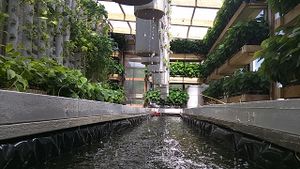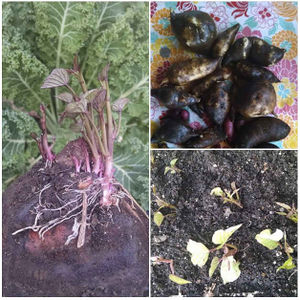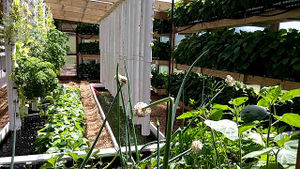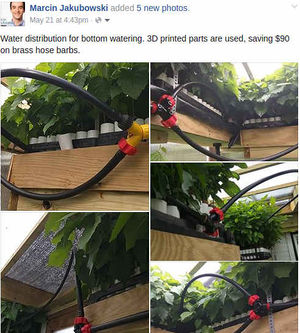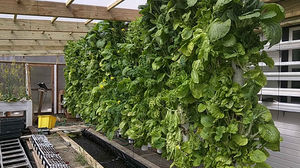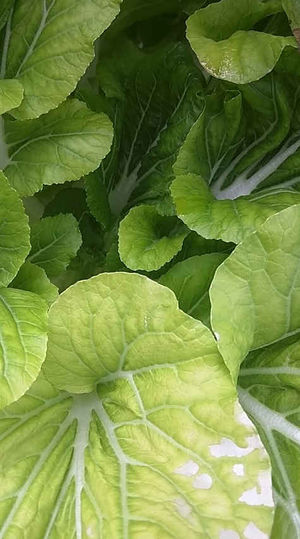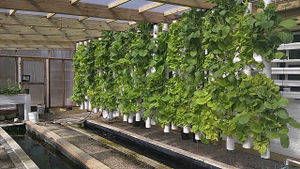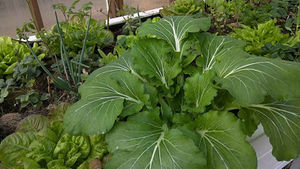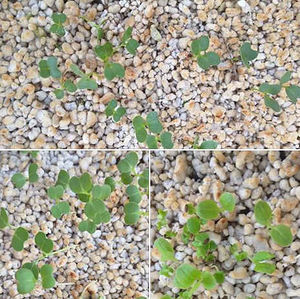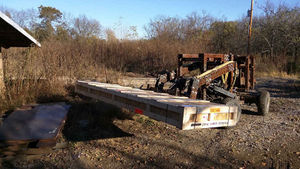Aquaponic Greenhouse Log
For all available greenhouse documentation, go to Aquaponic Greenhouse
Mon Apr 8, 2019
Spring is here, time to summarize thermal results. 1-2 kW Submersible hot water tank heaters corrode after about a month of use. They build up scale, and eventually the copper is eaten through. Ended up using 4x300W aquarium heaters to keep around 60F in the coldest times - coldest went down to about -10F outside. This is about $50 more in electricity per month (bill $100 total), but much easier than rilunninh stove. The other pond drops down to 38 without heat, so the remaining fish in there turned into fertilizer. South pond is fine.
Microhouse goes below freezing in the mid of winter, and we can't use green house heat as is due to high humidity - so we need to do a heat exchanger so house wouldn't freeze if we just use solar thermal. There's plenty of heat, just not it's distribution. Sounds like a global issue.
I let chickens in nto the aquaponic room, and Red fell in the water at 65F. I found her motionless floating in the water, she was stunned but warm. I put her in a hay box with a towel, and in the morning, she stiffened up. So we now have 3 of 4 chickens left, still laying eggs once in a while in winter. I am letting them out, but since we don't spend a lot of time in the microhouse experimental facility now, Catarina decided to move the chickens to the Seed Eco-Home.
Tue Feb 5, 2019
Pond 1 went down to 40 after coldest day. Pond 2 went down to 53. Pond 2 has 1 kW of heat. Turned on hydronic stove for backup heat. Microhouse Complex froze to about 29F. Within 1 week, 65 fish died over 4 days. First day - 5 fish harvested for food, as it was freeze kill. Later days fish didn't look as great. Largest fish was 13 inches. Composted in worm tower (started 2 weeks ago) and rest composted in chicken house soil beds. This is the second largest kill - first was leaving fill water on in the summer, 150 fish dead in both ponds as water spilled from one tot.he other. That is a disadvantage of ground level pond except for case of overspill. Learnings: automated refill and leak detection. Automated temp and parameter measurement with warning alarms. Passive heat via hillbilly would be sufficient, as only a small fraction of solar heat is captured into the water on sunny days. Maybe partial harvest for winter with only breeding stock left over. Partially buried ponds with wood framing for prevention of cave-in.
Optimal system would be a community Enterprise which generates clear exchangeable value. Part of conservatory space + combined heat power with hydronics, saturated water for night power, solar excess stored as heat both thermal and PV, Hillbilly heater, integrated with hydronics. Potential cooling with cold water in summer, but moisture issues must be resolved. Pellet stove, hydronic, with steam engine for CHP.
Tue Jan 29, 2019
Pond 1 is at 45F and pond 2 is at 58F. Coldest today - will be -12F.
Sun Jan 27, 2019
Pond 1 is at 47F and pond 2 is at 59F. Pond 1 is unheated, and Pond 2 has a 1 kW heater. Pond 1 drops 3 degrees per day until stabilization atround 47.
Dec 30, 2018
After sunny day and high of 46, pond 1 is 61F at 6 pm and pond 2 is 68 - it had 1kW last night and 1300W from solar today.
Dec 28, 2018
Ponds without heat. Pond 2 is connected to Faculty House 1300W PV array. Heating is minimal - and I wonder if it is load mismatch since it's 560V open circuit DC, going into a 4500W 240V water heater heating element. There is some heat, but it certainly looks like it's not at the max power point - so getting a fraction of the energy. Temp is for example 61 if other pond is 59. Today it was 53 (cold and cloudy), while Pond 1 was 58 F with 1kW of power from 120V ac house grid power and 4500W 240 heat element. Note that debris accumulates on heater element rather quickly and probably loses 25-50% heating ability through the buildup - so it must be. Leaned daily.
Jun 1, 2018
Pond 1 sprung a leak, such that there is only 24" of water. (See image under Table of Contents)
May 6, 2018
Layering a fig in the greenhouse -
Apr 11, 2018
Every spring, plants come back to life in the aquaponic greenhouse.
Thu Mar 8, 2018
Planning the chicken coop for the Aquaponic Greenhouse II:
- Moisture is bad for chickens, particularly in the winter. On the aquaponic greenhouse I, the chicken coop is placed on a separate room, away from the ponds and humidity. The aquaponic greenhouse II does not have a separate room. It is also smaller. For this reason, we decided not to install the coop inside the greenhouse.
The requirements for this outdoor coop are:
- The obvious: it must have a roost, a nesting box, be weather resistant and predator-proof.
- It must have a droppings tray to make it easier to clean. The mesh bottom we have on the aquaponic greenhouse I coop is not working. The droppings do not fall below it. To clean it it's necessary to crawl into the chicken coop and haul the manure out. Ideally, the new coop would have a removable tray while still allowing for a mesh bottom and vermicompost bins below.
- It should be moveable as the ideal location for the summer (in the shade) is different from the ideal location in the winter (in the sun). This can be accomplished with a coop light enough to be be picked up by two adults and moved to another location seasonally. Adding wheels to the coop might help with this. Ideally, this coop would also be retrofittable into a chicken tractor.
- It should have a sheltered outdoor area to allow the girls to spend time outdoors out of the rain and sun.
- It must have adequate ventilation while avoiding drafts. In the aquaponic greenhouse I, this is achieved with the greenhouse's roof vents, which are located high above the roost. A new coop also requires vents above the roost.
- It must have raccoon-proof locks on all possible openings as well as hardware cloth on vents. Locks are necessary on all doors, on the nesting boxes and droppings tray. Raccoons have been known to open sliding and turning locks. The only truly raccoon-proof lock is a padlock with the key removed or a combination code.
- It must allow for the installation of an automatic door.
Tue Feb 27, 2018
Late winter. Sweet potatoes sprouting.
Fri Mar 3, 2017
Late winter greenhouse - see to the right.
Tue Feb 14, 2017
Nitrite is at 0.5 ppm. Normal, still with towers only doing the filtration. Will install swirl filter as many fish are 12" and more feeding should occur.
Fri Oct 7, 2016 ~ Vertical Growing Towers Substrate Testing
The current vertical growing towers all contain no substantiative substrate beyond physical media in the form of a long rectangular sponge. Although this works, the chemical and biological processes of the plants are completely dependent on the water quality which can be difficult to control in an ever-changing aquaponic system and makes growing of different crops within the same system restrictive, if not improbable.
More... http://opensourceecology.org/wiki/William_Log
=Mon Jun 20, 2016=
See notes on the nut breeding in the pictures on the right. Summary: The second pond Ph is too high. New fish are growing well, but plants are weak. The first pond also - lettuces are not robust. Kale looks great. Mint is looking crappy. Fish are great - eating lots, water temp is 77-84. It's hot in the greenhouse. Improvements: Priorities are to (1) establish reliable breeding so that we can have reliable fish stock including for sale - and to optimize the fish population. (2) Establish duckweed culture to feed the fish as much as possible. Outside ponds integrated with a summer system would be great for this, and they could filter the fish water while excess duckweed drains readily into the fish pond. (3) Establish robust vegetable growth as a revenue model - 1000 plants means 250 plants per week sold - revenue model of at least $1/plant - but more like $1.5 for $1500/month production. This is solelely from 2 ponds totaling 3000 gallons, and 44 towers with 22 plant holes each. A careful density management plan would have to be established to optimize space, with extra towers for young plants, which are subsequently spaced out at maturity. We know this can be done. (4) Establish fish production plan for 3 lb fish per day production - 90 lb/month - or $270/month at $3/lb whole weight. Effective catching system would have to be developed. (5) Establish effective spirulina bioreactor for producing dietary supplement for the household. (6) Establish worm towers as tilapia food. Best would be integration with humanure system, if this could be automated effectively. (7) Develop production workflow for mushrooms. Space under the plant shelves on the walls is perfect for mushroom buckets, without taking any extra space.
Sun Jun 14, 2016
New fish spawned in pond 2.
Fri Jun 3, 2016
Outstanding system issues: pH off in pond 1; pH off in pond 2; heating it working, pond 1. Heating not installed, pond 2. Dish propagation setup; drip system not working robustly, both ponds; timer needed for both drips. Plants drying out in towers. Robust nutrient setup. Foliar spray regime. Pond refilling system setup. Door screens for IPM. Uneven temperature stratification. Plant mix needs refinement for diversity.
Sun May 29, 2016
Tower set 2 - 81 plant spaces available. These did not take. Some dried from drip not getting to the plants. Tower set 1 - 144 spaces available. 225 total available, or 957. 24% free. Towers plantings spreadsheet - [2]
Wed May 25, 2016
Tue May 24
Pond1: ph 8.0, NH3 0.25, nitrites 0.5, nitrates 0.
Pond 2: ph 8.2, NH3 0.25, nitrites 0, nitrates 0.
Sat May 20, 2016
Pond 1: pH 8.2 amended with ACV to 7.4, NH3 0.25
Pond 2: pH 8.4 amended with ACV to 7.4, NH3 0.5. Removed manure tea bucket, started new manure tea outside of pond. Planted lettuce to replace dead plants.
Fri May 20, 2016
Pond 2: pH 7.4, NH3 0.25, nitrites 0, nitrates 0.
Thu May 19, 2016
Printed Female Hose Thread (FHT) to 1/2" hose barb fitting. Menards doesn't have these. They have it [3] only special order. This is probably the one I want (appears mislabeled, as Hose Thread is only 3/4" (see wikipedia [4]) - [5] - but at $7, that is $70 saved, as I need 10 total for watering all the shelves.
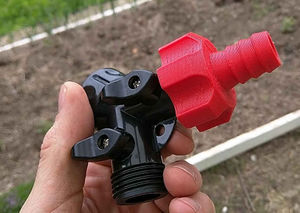
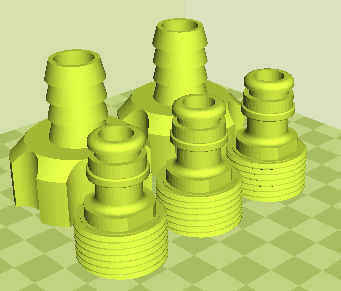
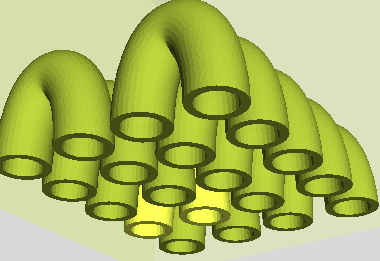 . U-barb for making tight u-turns with 3/4" irrigation pipe or other poly pipe for the purpose of heat exchangers. This u-turn goes inside the pipe sections that are to be joined. Poly pipe should be heated to allow easy application. The current application is u-turns for 500' of 3/4" black poly tubing - a 3.5kW heat exchanger for heating aquaponic ponds on solar radiation and some heat from the ceiling of the greenhouse. Download STL - 3/4" U Barb.
. U-barb for making tight u-turns with 3/4" irrigation pipe or other poly pipe for the purpose of heat exchangers. This u-turn goes inside the pipe sections that are to be joined. Poly pipe should be heated to allow easy application. The current application is u-turns for 500' of 3/4" black poly tubing - a 3.5kW heat exchanger for heating aquaponic ponds on solar radiation and some heat from the ceiling of the greenhouse. Download STL - 3/4" U Barb.]] Also 3D printed u-turns for pond heat exchanger - heat exchanger goes on the ceiling.
Wed May 18, 2016
2" fish died, looked like its eye was eaten. Body was still fresh.
Mon May 16, 2016
One 2" fingerling died in pond 1. Transfered 1 more small fish to Pond 2, for a total of 3 small (1") and 8 medium (6").
Sun May 15, 2016
1/2 gallon of distilled vinegar in pond 1 brought pH down to 7.0.
Second tower set all planted up. Moved 8 medium fish to Pond 2. Ph looks good, nitrates near zero.
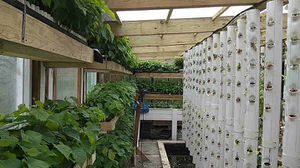
Sat May 14, 2016
Put in a shovel of manure into Pond 2, duckweed there is whiting out. Ready to install hydronic solar heating, and seed the fish in Pond 2. Nitrite level in both ponds - 0.1 ppm pond 1, 0 in pond 2 right after manure. PH in pond 2 is 8.4, pond 1 is 8.2. Reason for plants not growing robustly. Nitrate - pond 1 - 3 ppm- pond 2 - 0 ppm. Added 20 g vitamin c to pond 2, no visible pH change. Added 3/4 gal Apple cider vinegar, pH dropped to 7.4. Adding 280 500mg tablets still didn't get pH down - still at 7.6 in pond one. Will get some apple cider vinegar.
Tue April 19, 2016
Outbreak of fungus gnats. They eat roots if there is no fungus. Compost tea - they eat it instead of roots. Sprayed today with 780 ml of 1% Bronner's soap solution. Ron Whitehurst is sending beneficial nematodes, and hypoapsis. Immediate hit is the soap solution. Visibly, gnat adults appear to die off in seconds upon contact.
April 2016
Alec Log's Aquaponic Greenhouse Planting plan.
Wed Apr 13, 2016
March and April are such that the greenhouse beat obviates need for running the stove. However, the pond temperature goes down to 60F, in which case we ran the stove - about once a week. Now Apr 13, water is 72 after heating 2 days ago - so maybe now with hot days water temp never goes below 70. Fish are active above 70, below 70 they hardly want to eat. So essentially - March to begin of April is the period when we don't have to run the stove, except to heat the ponds. Temp on average in the house is 60 and above without heat in Mar- early April. Now it appears the temp will just keep going up.
Tue April 12, 2016
Seeded 3 trays of Aquaponic Greenhouse Planting.
Mar 23, 2016
This is how the aquaponic greenhouse plant wall of hanging towers looks like with bok choi going to flower and plants at the end of their cycle. This planting is from Nov. 11, 2015 in the temperate zone - minimum winter temperatures were -10F and it got down to freezing in the greenhouse on a couple of nights. Plants have been picked through many times. Ready to install second wall like this, for a total of 48 towers. IPM is going well with ladybugs which were originally natively in the house and which propagated to feed on the aphid population. Total of 48 towers produces 1056 plants, or about 170 per week assuming 6 week complete growout cycle - but this cycle in the towers would be more like 4 weeks if starts are done in perlite for 2 weeks prior to the towers - so more like 250 plants per week. Fish water without heating now remains at 62F, which means largely inactive fish. We still run the hydronic heat once in a while to get the pond temperature up to 72F, in which case the fish are very active. Next step is putting the nut seedlings shown in trays on the ground - onto bottom-watered shelves at the front and sides of greenhouse, as being developed at http://opensourceecology.org/wiki/Aquaponic_Greenhouse_Workshop.
Mar 2, 2016
See bok choi picture on the right. Fry is numerous, and so are intermediate 1.5" size fish in pond. Population of fish is exploding, and will be ready for expansion to second pond soon.
Feb 25, 2016
See Egg CSA for $64/hour earning potential.
Feb 20,2016
See Mushroom Log to graph the growth of mushrooms over time. Mushrooms are done after 3 months of fruiting.
Feb 18, 2016
Check out this aquaponics madness of civilization under construction. These are the results to date of growing plants in towers using foam growing medium watered by fish tanks that are below the towers.The fish have increased to hundreds in the pond below, with about 10 lb of fish mass total feeding these plants in foam-filled open source g-towers by Larry Athey. We are considering a follow-up workshop for doing another aquaponics build, taking our experience further. We are still installing systems, where the duckweed/azolla, aquatic worms, spirulina, sand beds, biochar beds, and more compost beds are to be installed. In the meantime, we are starting 10,000 nut seeds next week. We are considering an Entrepreneur-in-Residence position to work out the full open source economic model for the aquaponic greenhouse. Initial results are promising, in that doubling the hanging towers has a yield estimate of 160 mature plants harvested per week, clearly showing the advantage of using vertical space: 22 plants instead of 1 plant per square foot. Systems description: http://opensourceecology.org/wiki/Aquaponic_Greenhouse_Workshop
.
Mon Feb 1, 2016
- Indicator fry in small gallon container are still dying. Since Friday, nitrite has gone down slightly. I was hoping filter would eat it all up by now. May be instructive to do a calculation on abatement time given the filter volume, to know what to expect.
- Nitrate level is about 20 ppm.
Fri Jan 29, 2016
Ammonia and nitrite spike. Several of the fish caught in a gallon separate container died. Took measures by reducing feed, and running plant tower filters through the night.
Sat Jan 23, 2016
- Sent inquiry to Ron on what appeared to be amblyseius (thrips eliminator insect) on the towers - but I suspected it may actually be aphids.
- Started 5 gallon compost tea bucket fd by a teabag of composted cow manure for additional fertility on growing towers.
- Floating Fish Food - started on a 50 lb bag of Floating Fish Food from Orscheln's - [6].
- Caught about one more dozen fry from the big pond, considering setting up another 55 gallon drum for the fry in the pond, but something easier to catch would be nice if we want to catch the fish for market more easily. A smaller floating cage would be a good idea - with free exchange of nutrients and water with the larger pond. This is a great 3D printing opportunity - one cubic foot open water cages for fry. Having a number of these set up would allow easy grading and harvest for sale.
- One good idea that emerges on economics is taking 6 towers to market (out of 50 total towers, where we now have only 24 set up) - assuming total 6 week growth time, a conservative time. At $1-$3 per plant - that would be $160-$480 per week revenue just from greens that grow in the towers. Total of about 1000 plants in the towers means planting out one tower (22 plants) per day - which would be a pleasant 15 minute task. If packaging means taking entire towers to market - so time requirement is essentially the seeding time. At about 1 plant planted per minute - that comes out to $1-$3/minute - or $60-180 revenue from that hour of planting - plus a trip to market - which is another 4 hours or so. Thus, earning potential is about $12-36 per hour, given negligible cost of fuel, water, and electricity to run pumps. This assumes water is harvested locally from ponds or catchment, and electricity is solar, and we go to market on pelletized charcoal gasification.
Fri Jan 22, 2016
Noticed first aphids - on several plants out of 500 in the towers. Also, the plants planted in the second batch did not do as well. Once could be poor placement of Net Pots, where I just put them in without snugging them up for good contact with the filter medium. Leaned out fish water could be another issue: just 7 adult fish + few small ones plus hundreds of babies. Also noticed minor yellowing in one or 2 bok choi plants (of 100), implying nutrient deficiency.
Thu Jan 21, 2016
School of hundreds of tiny fish appeared in pond 1. I also saw the first small school of 20 or so one week earlier, and yesterday, an intermediate size appeared - implying at least 3 generations of babies born.
Jan 27, 2016
Installed more towers for a total of 24 with 22 plants in each tower.
Dec 23, 2016
First compost bed thriving. Bok Choi etc are doing well in the Aquaponics greenhouse, a psychology boost compared to the cold outside.
.
Sun Dec 14, 2015
10 double towers are now installed, and planted with small plants. This is our bio filter. Goal is to see the production levels from 50-100 towers - can it really be 50-100 plants per day harvest? What fish population is required to sustain it so that the biofuel tee is effective, and is the bio filter sufficient without the plants in place?
Sun dec 7, 2015
Fed some, of the last apples from orchard to the chickens, maybe a week of apples left for an apple per day. Should invest in walk-in cooler to extend apples - a lot have rotted, maybe 25% total.
Mon Nov 30, 2015
First flush of mushrooms. 2.25 lb in one bucket. Harvested over 3 days.
Nov 23, 2015
Seedlings almost ready for transplanting into towers.
Sun Nov 22, 2015
Released aphidoletes, planted beans as indicator plants for pests. Small fish are very vigorous, large ones are looking good. Kale, lettuce, and bok choi is almost getting second leaves. Few strawberries are coming into fruit. Duckweed and azolla appears to be propagating.
Sun Nov 15, 2015
Cleaned out blackworms.
Mon Nov 16, 2015
Released predatory mites and thrips eliminator from Ron Whitehurst's Rincon-Vitova Insectaries.
Nov 5, 2015
Greenhouse panels arrive.
.
